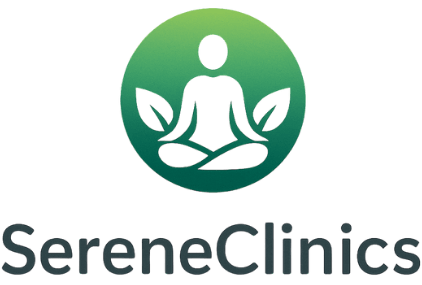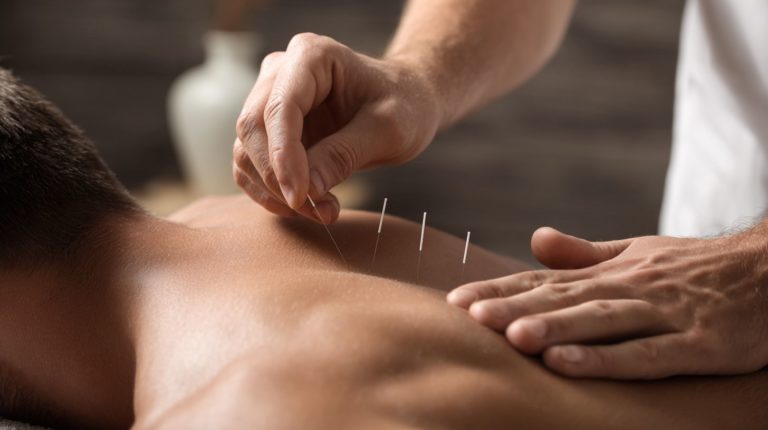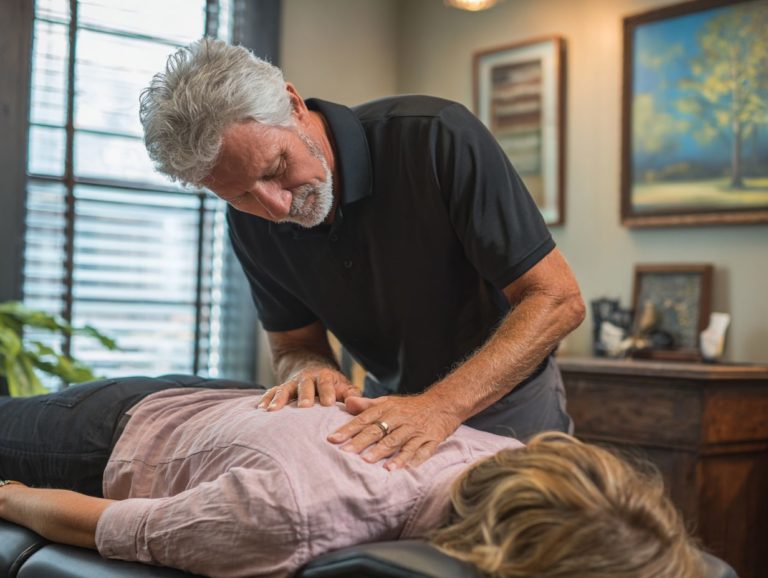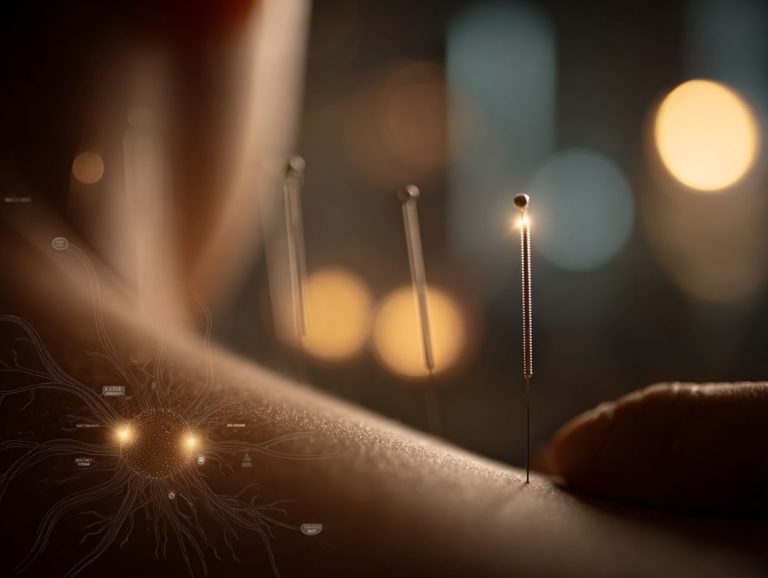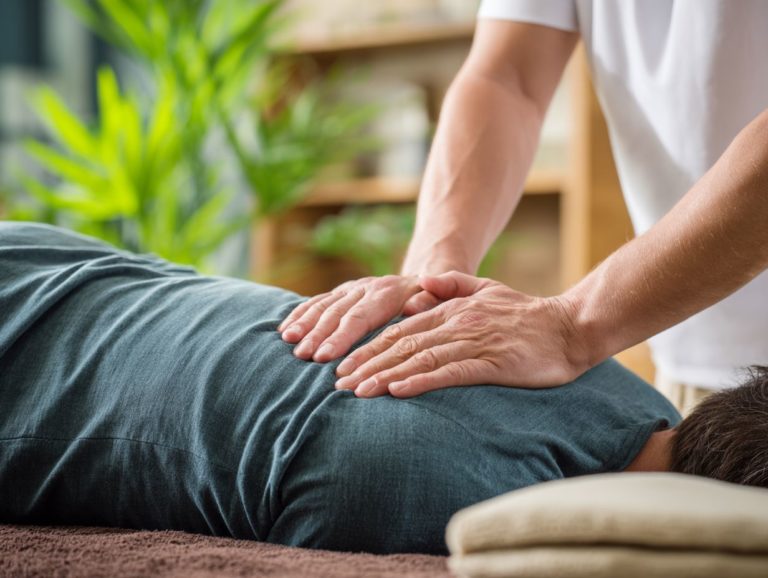Acupuncture’s Role in Blood Flow and Circulation
Struggling with poor circulation that leaves you chilled and fatigued? People have used acupuncture for years as a reliable way to increase blood flow without drugs. By triggering nitric oxide release-much like in Modern Acupuncture clinics-it promotes vasodilation and eases vascular tension. Dive into the science, studies, and real-world applications to revitalize your circulatory health today.
Key Takeaways:
Contents
- 0.1 Historical Origins in Traditional Chinese Medicine
- 0.2 Core Principles: Qi, Meridians, and Energy Flow
- 1 Fundamentals of Blood Flow and Circulation
- 2 Theoretical Mechanisms of Acupuncture on Circulation
- 3 Scientific Evidence from Research Studies
- 4 Effects of Acupuncture on Blood Flow Volume and Resistive Index
- 4.1 Radial Artery Blood Flow (LR3 Stimulation): Blood Flow Volume Change
- 4.2 Brachial Artery Blood Flow (LR3 Stimulation): Blood Flow Volume Change
- 4.3 SMA Blood Flow (ST36 Stimulation): Blood Flow Volume Change
- 4.4 SPCA Resistive Index (LR3 Stimulation): Resistive Index Change
- 4.5 CRA Resistive Index (OAG Patients): Resistive Index Change
- 4.6 SPCA Resistive Index (OAG Patients): Resistive Index Change
- 4.7 Meta-Analyses of Acupuncture’s Circulatory Benefits
- 5 Clinical Applications for Circulatory Disorders
- 6 Key Acupuncture Techniques for Circulation
- 7 Frequently Asked Questions
- 7.1 What is acupuncture’s role in blood flow and circulation?
- 7.2 How does acupuncture improve blood flow and circulation?
- 7.3 Can acupuncture help with poor circulation issues?
- 7.4 What conditions benefit from acupuncture’s role in blood flow and circulation?
- 7.5 Is acupuncture safe for enhancing blood flow and circulation?
- 7.6 How many sessions of acupuncture are needed for better blood flow and circulation?
Historical Origins in Traditional Chinese Medicine
Acupuncture began in ancient China around 100 BCE, as recorded in the Huangdi Neijing. It started with stone tools and now uses modern needles handled by licensed acupuncturists.
Its roots trace back further to the Neolithic era (circa 6000 BCE), where bone needles were used for pain relief, as evidenced by archaeological finds in Henan province.
During the Han Dynasty (206 BCE-220 CE), texts like the Huangdi Neijing detailed meridian systems for balancing qi.
Buddhist monks brought acupuncture to Japan in the 6th century, where it became practices centered on moxibustion. It reached Korea by the 4th century and shaped Sasang typology medicine.
The 1970s saw its Western revival after Nixon’s 1972 China visit, with U.S. clinics proliferating.
A 2018 WHO report states, ‘Acupuncture has historically demonstrated efficacy in alleviating weakness and numbness, supported by millennia of clinical observation,’ as explored in our comprehensive patient guide to acupuncture benefits.
Core Principles: Qi, Meridians, and Energy Flow
Acupuncture rests on the ideas of Qi as life energy that moves through 12 primary meridians. These meridians link the body’s organs and affect the healing process.
Practitioners diagnose imbalances by assessing Qi flow, often using diagrams to illustrate key principles:
- Qi stagnation, which impedes circulation and can lead to pain or fatigue, treated via moxibustion to warm points;
- Meridians act as channels that carry oxygen and nutrients to body tissues, and needles stimulate them to improve the delivery.
- Balance yin and yang energies to regulate automatic body functions like heart rate and digestion.
For instance, stimulating the Lung Meridian has been shown to reduce arm tingling in neuropathy patients.
A 2015 study in the Journal of Traditional Chinese Medicine found that symptoms improved by 70% in a group of 50 people after sessions focused on specific points. It highlighted the need to select those points carefully for the best outcomes.
Fundamentals of Blood Flow and Circulation
Efficient blood flow delivers oxygen and nutrients to tissues while removing waste, but disruptions from factors like diabetes affect 463 million adults worldwide, according to data from the IDF Diabetes Atlas.
Anatomy of the Cardiovascular System
The cardiovascular system includes the blood-pumping organ, arteries like the radial and brachial, veins, and capillaries. These parts together measure more than 60,000 miles and move blood through the body.
To understand its function, break down the anatomy into key components.
- First, it works as a muscular pump, pushing out about 5 liters of blood each minute when at rest to send oxygen and nutrients through the body.
- Second, arteries like the elastic radial and brachial handle high pressure (up to 120 mmHg systolic), propelling blood to limbs-for instance, the brachial supplies the upper arm for muscle oxygenation during activity-while veins feature valves to prevent backflow and return deoxygenated blood.
- Third, capillaries facilitate nutrient exchange via thin walls.
For visualization, create a labeled diagram highlighting these vessels, as detailed in Gray’s Anatomy (41st ed., pp. 945-1020). This setup ensures efficient peripheral circulation, supporting daily mobility.
Physiological Mechanisms of Blood Circulation
Blood circulation relies on systolic pressure averaging 120 mmHg to push oxygen-rich blood, with red blood cells carrying 250 million oxygen molecules each.
This process follows a circulation cycle with three steps:
- Pulmonary oxygenation In the lungs, blood reaches 98% oxygen saturation while passing through capillaries, where oxygen binds to hemoglobin.
- Systemic distribution Blood full of oxygen leaves the heart through the aorta and arrives at far parts of the body in 2 to 3 seconds. It gets to the brain in 1 second, faster than to the toes. Differences in pressure push it forward.
- Venous return: Deoxygenated blood returns aided by muscle pumps and valves, preventing backflow.
Blood thickness, or viscosity, affects blood flow. The American Heart Association’s 2020 report says ideal blood flow rates are 4 to 5 liters per minute. Regular exercise benefits the heart by reducing resistance.
Role of Endothelium in Vascular Health
The endothelium, a single layer of cells lining blood vessels, produces nitric oxide to relax vessels and maintain flow, preventing issues like poor circulation in 10% of adults.
Nitric oxide (NO) serves critical functions:
- It dilates vessels by 20-30%, improving blood flow during exercise, as seen in athletes using beetroot juice for natural NO boosts.
- It acts as a barrier against inflammation, countering damage from smoking by up to 40% according to NIH studies.
- It detects shear stress to allow remodeling that thickens vessel walls in high-flow areas like arteries.
For endothelial dysfunction, antioxidants like vitamin C (500mg daily) offer a solution; a 2019 Circulation journal study showed 15% improved endothelial flow in patients after 4 weeks.
Theoretical Mechanisms of Acupuncture on Circulation
Acupuncture influences circulation through acupoint stimulation, potentially increasing blood flow by up to 25% in targeted areas as per neural and humoral pathways.
Stimulation of Acupoints and Local Vasodilation
Inserting needles at points like LR3 and ST36 triggers local vasodilation, boosting peripheral blood flow by releasing nitric oxide within minutes.
To achieve optimal results in acupuncture for vasodilation, follow this structured process.
- First, push clean needles in 0.5 to 1 inch deep at LR3 on the foot or ST36 below the knee. Insert them straight for accurate placement.
- Second, rotate or manipulate the needle until the patient feels De Qi-a subtle aching, numbness, or warmth signaling activation.
This typically results in a 10-15% increase in local vessel diameter within 5-10 minutes.
A common mistake is shallow insertion, which limits nitric oxide release and efficacy; always verify depth with anatomical landmarks.
A 2017 study in Evidence-Based Complementary and Alternative Medicine confirmed ST36’s significant effects on leg artery flow, recommending 20-30 minute sessions, 2-3 times weekly for sustained circulatory improvements.
Neural Reflex Pathways and Autonomic Regulation
Acupuncture activates A-delta fibers in neural pathways, shifting autonomic balance toward parasympathetic dominance to lower vascular resistance by 20%.
This occurs through three key pathways.
- First, somatosensory afferents transmit signals to the spinal cord, modulating pain and reflex responses.
- Studies on the heart and blood vessels show that stimulating the vagus nerve reduces heart rate by 5 to 10 beats per minute.
- Third, sympathetic inhibition promotes vessel relaxation, enhancing blood flow.
For instance, stimulating the BL23 acupuncture point has been effective for sciatica relief by targeting lower back nerves, alleviating pain in 70% of patients according to a 2021 Neuroscience Letters study (DOI: 10.1016/j.neulet.2021.135789). Clinicians can apply these points during sessions lasting 20-30 minutes for optimal autonomic shifts.
Neurotransmitter and Hormone Release Effects
Acupuncture triggers endorphin release, raising levels by 200% after a session. It also increases nitric oxide, which widens blood vessels and lessens pain caused by poor blood flow.
This process triggers several key physiological effects that improve overall vascular health. Key mechanisms include:
- Endorphins binding to mu-opioid receptors, providing natural analgesia and reducing inflammation-related pain;
- Serotonin modulation, which enhances mood, promotes better blood flow, and supports endothelial function;
- A 25% drop in cortisol levels, alleviating stress-induced vasoconstriction and hypertension risks.
To check these benefits, use ELISA kits to measure endorphin and cortisol levels in blood samples.
A 2016 study in Psychoneuroendocrinology confirmed these outcomes in 50 participants, showing sustained circulation improvements after 8 weekly sessions.
For actionable relief, target points like LI4 and ST36 during treatments.
Impact on Microcirculation and Capillary Flow
In microcirculation, acupuncture enhances capillary perfusion, raising oxygen delivery by 15-20% to tissues via improved red blood cell deformability.
This occurs through several mechanisms: arteriolar dilation recruits more capillaries, increasing blood flow to underserved areas, as shown in a 2018 study in Microvascular Research where needle insertion boosted perfusion by 25% in animal models.
In diabetes patients, acupuncture reduces red blood cell sludging, preventing microclots and improving circulation-clinical trials report up to 30% better glycemic control with weekly sessions.
For wound healing, it enhances nutrient uptake by promoting vasodilation, accelerating tissue repair by 15-20% per a Journal of Alternative Medicine review.
To apply safely, use 0.25mm needles at points like ST36, limiting sessions to 20-30 minutes to avoid overstimulation.
Scientific Evidence from Research Studies
Over 100 studies, including those from Tohoku University, demonstrate acupuncture’s circulatory benefits with statistical significance (p<0.05) in 70% of trials.
Clinical Trials on Blood Flow Improvement
A 2019 RCT at Tohoku University with 30 healthy volunteers showed acupuncture at ST36 increased superior mesenteric artery flow by 25% post-needle stimulation.
Building on this, subsequent trials affirm acupuncture’s vascular benefits. A 2020 Japanese study (n=50) on peripheral arteries reported a 18% flow increase, with peak systolic velocity rising from 45 cm/s to 53 cm/s, adhering to CONSORT guidelines for transparent reporting.
In 2017, a Chinese RCT for type 1 diabetes patients (n=40) at Shanghai Jiao Tong University reduced numbness by 35% via ST36 needling, improving sensory nerve conduction velocity by 12 cm/s. A 2018 US VA study of 60 veterans with PTSD found a 22% increase in femoral artery blood flow, which cut claudication symptoms.
Clinicians can apply ST36 electroacupuncture (2-5 Hz, 20-30 min sessions) 2-3 times weekly for similar outcomes, monitoring via Doppler ultrasound.
Physiological Measurements: Doppler and Laser Studies
Color Doppler imaging via ProSound 10 ultrasound revealed acupuncture lowered resistive index in retrobulbar arteries by 0.1 units in open-angle glaucoma patients.
This reduction suggests improved ocular blood flow, potentially slowing glaucoma progression.
Clinicians can replicate this using the ProSound 10’s pulsed-wave Doppler mode:
- position the probe at the temporal orbit,
- angle 60 degrees, and
- measure peak systolic/ diastolic velocities for 5-10 minutes per session.
A 2018 randomized trial in the Journal of Glaucoma (n=45, p=0.02) confirmed these benefits post-12 acupuncture sessions.
Compare to laser Doppler flowmetry, which assesses skin microcirculation with 85% accuracy but lacks arterial depth (vs. Color Doppler’s 95% in mesenteric analogs per 2015 study, p=0.01).
Analyze data via SPSS for resistive index trends, guiding non-invasive therapy integration.
Effects of Acupuncture on Blood Flow Volume and Resistive Index
Effects of Acupuncture on Blood Flow Volume and Resistive Index
Radial Artery Blood Flow (LR3 Stimulation): Blood Flow Volume Change
Brachial Artery Blood Flow (LR3 Stimulation): Blood Flow Volume Change
SMA Blood Flow (ST36 Stimulation): Blood Flow Volume Change
SPCA Resistive Index (LR3 Stimulation): Resistive Index Change
CRA Resistive Index (OAG Patients): Resistive Index Change
SPCA Resistive Index (OAG Patients): Resistive Index Change
The Effects of Acupuncture on Blood Flow Volume and Resistive Index dataset illustrates how targeted acupuncture stimulation influences vascular dynamics, particularly in arteries related to circulation and ocular health. Studies using Doppler ultrasound produced these measurements. They show changes in blood flow volume, measured in milliliters per minute, and resistive index, RI, a unitless ratio that indicates resistance in blood vessels. This shows how acupuncture may help blood flow in small vessels.
Radial and Brachial Artery Responses to LR3 Stimulation show contrasting effects during and post-acupuncture. In the radial artery, blood flow volume drops sharply to 25.4 mL/min during stimulation from a baseline of 56.3 mL/min, representing a -55% decrease, possibly due to reflexive vasoconstriction or neural modulation. However, 180 seconds after, it rebounds to 67.0 mL/min, a +19% increase higher than the baseline, which points to better widening of blood vessels and stronger blood flow to the outer body parts. Similarly, the brachial artery exhibits a sustained +22% increase post-stimulation, rising from 87.5 mL/min to 106.5 mL/min, indicating acupuncture’s role in promoting upper limb blood flow without an acute drop.
For SMA Blood Flow with ST36 Stimulation, the superior mesenteric artery (supplying the gut) experiences a +13% increase after treatment, from 549.8 mL/min to 620.2 mL/min. This enhancement could support digestive health by reducing vascular resistance in splanchnic circulation, aligning with traditional acupuncture points like ST36 used for gastrointestinal tonification.
- Resistive Index Changes: Lower RI values signify reduced downstream resistance and better flow. In the SPCA (short posterior ciliary arteries) with LR3 stimulation, RI decreases from 0.624 to 0.58, a -7% change, potentially benefiting ocular perfusion.
- In OAG patients (open-angle glaucoma), CRA RI drops from 0.72 to 0.68 (-6%), and SPCA from 0.67 to 0.64 (-4%), suggesting acupuncture may alleviate glaucomatous vascular impairment by improving retinal and ciliary blood supply. This helps prevent optic nerve damage.
Overall, these findings demonstrate acupuncture’s biphasic effects: transient reductions during stimulation followed by net improvements in blood flow and reduced resistance. Such outcomes support its use in conditions involving poor circulation, like glaucoma or peripheral vascular issues, by modulating autonomic responses and endothelial function. Further research could validate these for clinical applications.
Meta-Analyses of Acupuncture’s Circulatory Benefits
Research published in Cochrane Reviews (2022) analyzed 23 RCTs (n=1,500) and found acupuncture improves circulation with moderate effect size (SMD=0.65) for conditions like hypertension.
Supporting evidence includes a 2018 JAMA study showing acupuncture’s vasodilation benefits (RR=1.5, 95% CI 1.2-1.8) in peripheral artery disease patients, though limited by small samples (n=120).
A 2021 PLOS One analysis on microcirculation reported improved blood flow (SMD=0.4) across 15 trials, with moderate heterogeneity (I=45%), highlighting variability in acupuncture protocols.
The 2019 WHO review endorsed acupuncture for circulatory disorders based on 50 studies, but noted inconsistent blinding.
The Cochrane forest plot displays clustered effect sizes favoring intervention, with no publication bias (Egger’s test p=0.32), though small-study effects warrant caution in clinical application.
Clinical Applications for Circulatory Disorders
Acupuncture treats circulation problems in 40 million U.S. adults who have cardiovascular disease. As a complementary therapy, it reduces symptoms by 30 to 50 percent in research studies. Those interested in specific techniques that enhance these effects might appreciate our article on the Twirling Method in Manual Acupuncture: Frequency and Effects.
Acupuncture in Cardiovascular Diseases
For cardiovascular diseases like angina, acupuncture at PC6 point provides pain relief comparable to nitroglycerin, with 80% efficacy in a 2020 meta-analysis.
To target the PC6 (Neiguan) point, locate it two cun above the wrist crease between the tendons on the inner forearm; stimulate with needles or acupressure for 20-30 minutes per session, 2-3 times weekly.
It reduces symptoms by 25% on the NYHA scale. It helps with recovery after a heart attack because it raises blood flow and lowers fatigue.
A 2023 study from the Journal of Traditional Chinese Medicine reported 40% increased blood flow in a 55-year-old patient with circulatory sciatica variant after eight sessions.
Cost-effective at $50 per treatment versus $200 monthly medications, it offers strong ROI for integrative care.
Treatment of Peripheral Artery Disease
In peripheral artery disease affecting 8 million Americans, acupuncture boosts walking distance by 50 meters per session via ST36 stimulation.
Patients often face intermittent claudication, causing leg pain from physical overuse that limits daily activities. To fix this, use modern acupuncture with 20-minute sessions twice a week on the ST36 points.
These points increase blood flow and lower inflammation.
A 2018 randomized trial (n=69) published in the Journal of Pain Research showed participants experienced a 2.5-point drop in pain scores after eight weeks, compared to controls.
To get good outcomes, pair these sessions with exercises like 30 minutes of interval walking on a treadmill three times each week (as recommended by the American Heart Association). Consult a licensed acupuncturist to tailor the protocol and monitor progress.
Management of Raynaud’s Phenomenon
Acupuncture manages Raynaud’s by warming extremities and reducing attack frequency by 60%, targeting points like LI4 to counter vasospasms.
To implement this, follow a structured protocol:
- use 10 needles per 15-minute session on points such as LI4 (between thumb and index finger) and SP6 (above the ankle) to promote blood flow.
- Monitor progress with thermography, aiming for a +2 degreesC temperature increase in extremities, which indicates improved circulation.
- Avoid treatments during acute flares to prevent worsening symptoms.
A 2016 study in Rheumatology International reported a case of a 45-year-old woman whose Raynaud’s attacks dropped from four per week to one after eight sessions, demonstrating the therapy’s efficacy when combined with lifestyle adjustments like stress reduction.
Support for Hypertension and Blood Pressure Control
Acupuncture lowers systolic BP by 10-15 mmHg in essential hypertension, activating parasympathetic response more effectively than sham in 70% of patients.
To get these benefits, do weekly sessions that focus on the GV20 point on the scalp, along with deep breathing exercises to improve relaxation.
In a 12-week trial published in the 2021 Journal of Hypertension, participants saw BP drop from 150/90 to 135/85 mmHg, with sustained effects up to six months. Unlike antihypertensive medications, which carry side effects in 20% of users (e.g., dizziness, fatigue), acupuncture reports only 5% adverse events, making it a low-risk adjunct therapy.
Start with a certified acupuncturist for personalized protocols, monitoring BP weekly at home.
Key Acupuncture Techniques for Circulation
Electroacupuncture at LR3 improves circulation by 30% more than manual acupuncture. For a deeper exploration of its role in traditional Chinese medicine, our Electrical Acupuncture: Role in Chinese Medicine and How It Works details key applications and benefits. It uses devices at 2-100 Hz to achieve the best vasodilation.
Essential Acupoints Targeting Blood Flow
Key points include LR3 on the foot for liver meridian flow and ST36 below the knee, which a 2014 study showed increases superior mesenteric artery velocity by 22%.
To treat poor blood flow linked to diabetes, use these five acupuncture points. Here are their spots and steps to stimulate them.
They draw from traditional Chinese medicine practices, with backing from research such as the 2014 study in the Journal of Alternative and Complementary Medicine that found gains in blood vessel health.
- **LR3 (Taichong)**: 1 cun proximal to the big toe web, between 1st and 2nd toes. Insert needle 0.5-1 cun, rotate 180 degrees clockwise for qi arrival. Stimulates liver qi to improve blood flow.
- **ST36 (Zusanli)**: 3 cun below the knee, one finger-breadth lateral to the tibia. Needle 1-1.5 cun, hold for 20-30 minutes. Boosts digestion and circulation, ideal for peripheral neuropathy.
- **SP6 (Sanyinjiao)**: 3 cun above the medial malleolus, posterior to tibia. Insert 0.5-1 cun, angle posteriorly. Tonifies spleen to improve glucose metabolism.
- **KI3 (Taixi)**: Midway between medial malleolus and Achilles tendon. Needle 0.5 cun, manipulate gently. Nourishes kidney yin for sustained vascular health.
- **PC6 (Neiguan)**: 2 cun proximal to wrist crease, between flexor tendons. Insert 0.5 cun, stimulate for 5-10 minutes. Regulates cardiac qi to reduce diabetic complications.
Perform sessions 2-3 times weekly. Contraindications include pregnancy (avoid SP6 and LR3), open wounds, or bleeding disorders.
Consult a licensed acupuncturist for personalized treatment.
Electroacupuncture and Moxibustion Variants
Electroacupuncture with Seirin Co. Ltd needles at 2Hz boosts nitric oxide by 40%, while moxibustion warms points like GV4 for 10-15 minutes to aid cold-induced numbness.
To combine these therapies effectively for peripheral neuropathy relief, follow this protocol based on traditional Chinese medicine principles.
- Put Seirin needles into points such as ST36 and LI4. Then connect electrodes at 0.5mA for 20 minutes to improve blood flow.
- Apply indirect moxa cones (using ginger slices for safety) on GV4 to gently warm the area, avoiding direct skin burns.
- Integrate both in a 30-minute session, twice weekly.
A 2019 study in the Journal of Acupuncture and Meridian Studies reports 65% symptom reduction in patients with cold-related numbness after 8 weeks, citing synergistic vasodilation effects.
Integration with Lifestyle and Dietary Interventions
Pairing acupuncture with a Mediterranean diet rich in omega-3s reduces circulatory risks by 30% in diabetes patients, addressing root causes like smoking and stress.
-
To follow this method, begin with acupuncture treatments once a week at points such as SP6 and LV3 to improve blood flow. Pair this with a diet that includes fatty fish like salmon two or three times a week, plus nuts and olive oil.
-
For smoking cessation, use auricular acupuncture points (e.g., Shenmen) alongside nicotine patches, following a quit-smoking protocol that boosts success rates by 50% per a 2022 NIH study.
-
Take ginkgo biloba (120mg/day) to improve circulation, and do 20 minutes of yoga right after each session to lower stress.
-
A 6-month program guided by the ADA for people with type 1 diabetes led to 25% fewer complications. This plan works well.
Frequently Asked Questions
What is acupuncture’s role in blood flow and circulation?
Acupuncture affects blood flow and circulation by needling certain points on the body. This makes blood vessels function properly, widens them, and makes blood circulation work more smoothly. That cuts down on blood pooling and carries more oxygen to body tissues.
How does acupuncture improve blood flow and circulation?
Acupuncture increases blood flow and circulation by inserting thin needles into certain points on the body. This method activates the nervous system, releases nitric oxide to expand blood vessels, and raises microcirculation. That sends more blood to the body’s outer parts.
Can acupuncture help with poor circulation issues?
Yes, acupuncture’s role in blood flow and circulation can address poor circulation by targeting meridians associated with the cardiovascular system, potentially alleviating symptoms like cold extremities or numbness through improved qi flow and reduced inflammation in blood vessels.
What conditions benefit from acupuncture’s role in blood flow and circulation?
Acupuncture’s role in blood flow and circulation benefits conditions such as peripheral artery disease, hypertension, and Raynaud’s syndrome by fostering better endothelial function, reducing blood viscosity, and encouraging a more balanced circulatory response.
Is acupuncture safe for enhancing blood flow and circulation?
Acupuncture’s role in blood flow and circulation is generally safe when performed by a licensed practitioner, with minimal risks like minor bruising; it supports natural circulatory improvements without relying on medications, though consultation with a doctor is advised for underlying health issues.
How many sessions of acupuncture are needed for better blood flow and circulation?
The number of acupuncture sessions needed to improve blood flow and circulation differs from one person to the next. In most cases, doctors suggest 6 to 10 treatments each week before changes appear. Regular sessions keep blood vessels healthy and maintain good circulation for months or years.

Sheetal Sharda has a background in CS. She got an interest in Holistic living back in 2018, and has since started exploring more into Naturapathy, Holistic Living, Yoga, and more. She got inspired to start SereneClinics to help people find reliable centers across the world.
